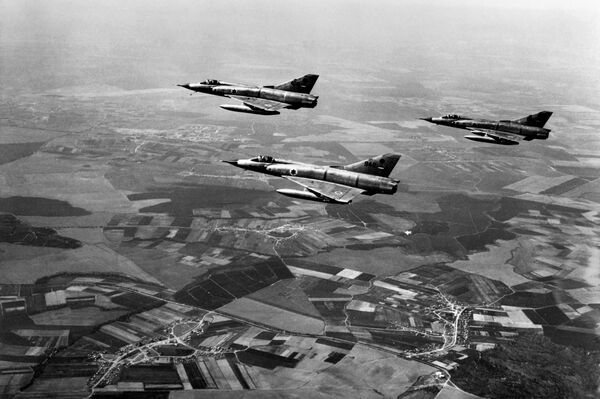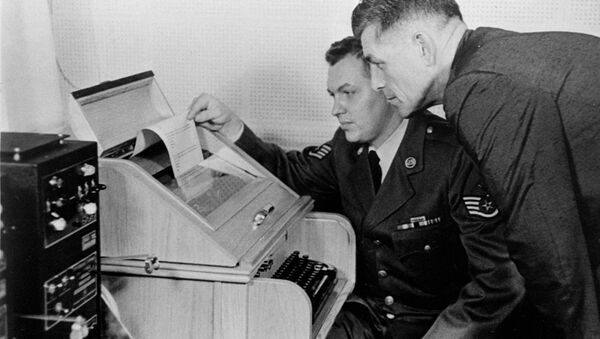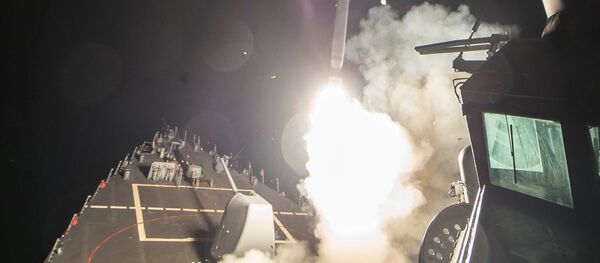The establishment of the "hotline" marked the culmination of much clamor in both superpowers for a method of direct interface between the blocs' respective leaders. One leading advocate was Harvard Professor Thomas Schelling, who had worked on nuclear policy for the US Department of Defense. He was keen to make the US government aware of the benefit of direct communication.
However, objections from hawkish elements within the US State Department and military effectively poured cold water on such aspirations.
The October 1962 Cuban Missile Crisis changed all that. The standoff, which had potentially apocalyptic potential, was a palpable demonstration to US President John F. Kennedy and Soviet Premier Nikita Khrushchev of the necessity of fast, direct communication.
#OnThisDay 1963, height of #ColdWar, first 24H direct hotline b/w Washington and Moscow established, greatly reducing risk of war outbreak pic.twitter.com/CyvmM3L9ea
— Foreign Brief (@ForeignBrief) August 30, 2017
'To Jaw-Jaw Is Always Better Than to War-War
The highly tense diplomatic exchanges over the course of the fortnight-long confrontation could take as long as six hours to be delivered — and decoding took even longer. In all, the US took almost twelve hours to unravel the meaning of Khrushchev's encrypted 3,000-word initial settlement proposal. By the time it was deciphered, Soviet demands had changed in response to developments.
Such spans of time were unsurprisingly deemed to be dangerously protracted in such a hazardous situation — although moreover, it was well-understood that the crisis could've been averted entirely, resolved before it even erupted, if such a platform existed.
In June 1963, representatives of the two countries signed the Hot Line Agreement in Geneva. The hotline would, White House spokespeople said, "help reduce the risk of war occurring by accident or miscalculation."
It was agreed the line would be used only in emergencies, not for routine governmental exchanges.
The first message transmitted over the hotline was on August 30, 1963 — Washington sent Moscow "the quick brown fox jumped over the lazy dog's back 1234567890" and all the Latin alphabet, as well as all Arabic numerals and the apostrophe, to ensure the keyboard and printer were working correctly.
#OTD 1963 A “hotline” between Moscow & Washington became operational to prevent the possibility of accidental #war. Photo shows the original pic.twitter.com/B3ytsz5e2P
— Navy Reading (@NavyReading) August 30, 2017
The hotline was tested hourly to ensure its continued function — US test messages have included excerpts from the works of William Shakespeare and Mark Twain, and encyclopedias — staffers are said to take special care not to include innuendo or imagery that could be misinterpreted as provocative or offensive, such as passages from popular children's book Winnie the Pooh. A bear is, after all, often considered the national symbol of Russia. Russian tests have included passages from the works of fiction legends Anton Chekhov and Fyodor Dostoevsky.
Aug 30,1963 — Hotline established between #Washington and #Moscow https://t.co/zNJv2w4K5v #History #Government #Russia #Politics pic.twitter.com/55PsZymvcU
— Richard Krivo (@RKrivoFX) August 30, 2017
The new technology was a momentous step toward the future, a precursor to the days American and Soviet leaders could simply pick up a phone and be instantly connected whenever either side wished. In popular culture, the phone quickly became to be known as the "red telephone" — although the hotline was never actually a telephone line, and no red phones were ever used outside Hollywood movies and TV shows.
Just for Show
The hotline was first officially used by the US following President Kennedy's 22 November 1963 assassination — the first official use by the Soviet Union was 5 June 1967 during the outbreak of the Arab/Israeli Six-Day War.

Other notable uses include the 1971 Indo-Pakistani War, 1973 the Yom Kippur War, the 1974 invasion of Northern Cyprus by Turkish forces, and several times during the Reagan Administration, with the Soviets querying US actions in Lebanon and the US likewise seeking clarification on the situation in Poland during the December 1981 — July 1983 period of martial law.
On top of making frequent appearances in political thrillers on the big and small screen, and the pages of novels, the image of a "red phone" connecting the leaders of the world's two leading nuclear nations has frequently appeared in political advertising, most recently in 2008 as part of Hillary Clinton's unsuccessful campaign for the Democratic Presidential nomination.
However, despite its enduring prominence in Western culture, the hotline — or, at least, the ideal it symbolically represented — has fallen into disfavor with Western leaders. Attempts by Russian leaders to establish a diplomatic bridgehead with Washington over the 2014 Ukraine crisis, and NATO actions in Eastern European countries bordering Russia, have repeatedly proven fruitless. The election of Donald Trump as President in November 2016 raised hopes in many quarters of the world of rapprochement between the two nations, but renewed, baseless anti-Russian sanctions passed August have seemingly neutered any such optimism.
While President Trump has since spoken of his belief the West and Russia will "eventually get along," there is as yet little tangible suggestion the steady decline of relations between the two will be reversed. After all, fresh off her failed presidential bid, in 2009 as Secretary of State Hillary Clinton infamously pressed the "reset button" on US/Russian relations for cameras in a meeting with Russian Foreign Minister Sergei Lavrov, and it was not long after the pair's dealings reached perhaps their frostiest level since the Cold War.





